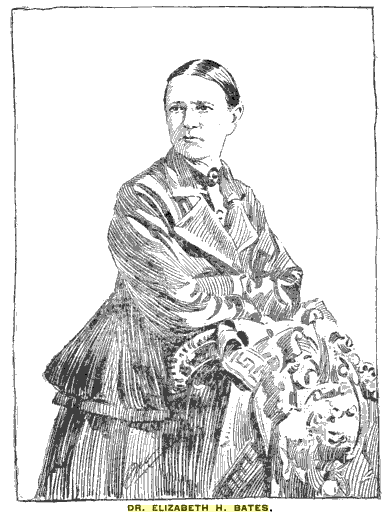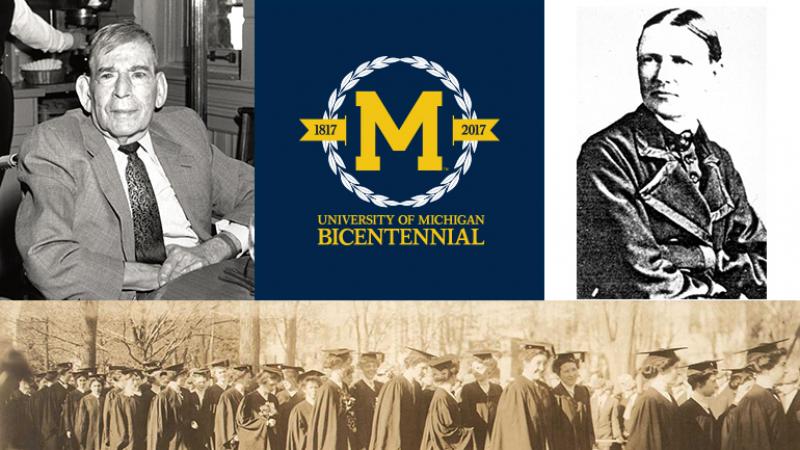
You are here
Dr. Elizabeth H. Bates

https://www.findagrave.com/memorial/85290099/elizabeth-hannah-bates
Dr. Elizabeth H. Bates died at her
home in New York city last week Wednesday,
aged 66 years. She was the
daughter of Dr. William Bates who practiced
medicine in Morris many years ago.
She was born at Morris and left there
when about thirty-six years of age. She
has since lived in New York, following
her profession until her health failed.
She frequently visited Morris since her
removal from that place and was well
known there.
Both her father and mother are buried
at Morris and she has no brothers or
sisters. Two aunts , Mrs. C.K. Hawkes
and Miss Mary A. Hanners, and a cousin,
T.H. Sayre, all of New York, accomp-
panied the body to Morris on Monday of
this week.
from The Otsego Farmer
published at Cooperstown, NY
15 April 1898, page 5.
DR. ELIZABETH H. BATES
Dr. Elizabeth H. Bates, who died April 6, 1898, at Port Chester, New York, left her fortune of $125,000.00 to the medical department of the University of Michigan for the endowment of the Bates Professorship of the diseases of women and children. This is the largest bequest ever given to the University and will yield an income of $6,000 a year. Even in the early years of Dr. Bate's practice when her income was small, she planned to leave whatever she might accumulate in the future to the University of Michigan, because it was the first in admitting women to its medical school on a par with men.
Dr. Bates was born April 1, 1832, at Charlemont, Massachusetts. She was of English ancestry on her father's side, of Scotch descent on mother's. Her great grandfather, Benjamin Hanners, came over from Scotland before the Revolution, settling in Boston. Disguised as an Indian, he assisted at the Boston Tea Party, and it was a family tradition that his chaise carried General Warren to the battle of Bunker Hill. Three generations of ancestors in the Hanners family lie in a vault under King's Chapel in Boston.
Dr. Bate's father, her grandfather, and her father's brother were all physicians. Her father was practicing at Charlemont, Mass., when she was born. He was a man of superior ability, clear and precise in expression, acutely observant, and of a medical judgment almost unerring in serious cases. Her mother was an invalid for many years. Dr. Bates was an only child, and when a little girl was so delicate that her father kept her out-of-doors and took her driving with him through the country districts included in his extensive practice.
She began her education in the public school of Charlemont, but when eight years old her father removed to Morris, N.Y., where she in a parochial school for some time, afterwards attending an academy in Gilbertsville. At sixteen she entered Mrs. Willard's Seminary at Troy, from which she graduated July 24, 1852. On returning from Troy she was twenty years old and so inured to regular occupation that she confessed that "she felt lost without it and did not want to do nothing as other girls did." She told her father that she wanted to study medicine, an ambition which she had cherished from her girlhood. He answered: "If you do, you must do it desperately. I want no halfway work. Think it over for two weeks, but do not speak to me of it until then." With a decision apparently characteristic, Dr. Bates answered that she was ready now, and her father at once started her in the work. She had read with him a year before even intimate friends knew of it. The Female Medical College of Pennsylvania was the only medical school open to women at this time and from this Dr. Bates was graduated in 1854.
For twenty years thereafter she practiced with her father in Owego. Both were successful in general practice, and she especially so in diseases of women and children. Her mother's death in 1872, and her father's two years afterward, were severe blows to Dr. Bates, and broke down her health, never robust and always taxed beyond its capacity. She missed the support of her father's experience and his companionship, but she continued to work, removing in 1882 to Port Chester, New York. In this community, where she lived until her death, she was a notable influence. The presidency of the board of health was given to her and she was a trustee of the Congregational Church, being largely instrumental in founding and supporting it. While not emotional or demonstrative in her religion, almost the last words she spoke were to ask about the success of a church entertainment given that evening to assist in payment of the church debt.
Dr. Bates contributed no writings to medical annals, though she wrote for local medical societies papers which she was urged to publish. She was well-read in scientific and professional literature and was a good literary critic. On the whole, however, she was a woman of deeds rather than words. The large fortune accumulated entirely through her own efforts is sufficient evidence of her medical skill and shrewd management. As as pioneer in women's practice of medicine, her dominant will and energy, and decided personal opinions, were leading factors in her success.
[The above biography is from "The Michigan Alumnus, Vol 4, page 369 published in 1898 by the University of Michigan Alumni Association.]
https://medicine.umich.edu/medschool/news/university-michigan-bicentenni...

MONUMENTAL GIFT YIELDS U-M’S FIRST-EVER PROFESSORSHIP
April 13, 2017 // FOUND IN: Updates & Resources, Top Story
Elizabeth H. Bates, M.D., top right, and Frederick G.L. Huetwell, top left, played major roles in the catalog of endowed professorships at the U-M Medical School. Bates’ gift, in particular, influenced the medical education of women at the university, as shown in the bottom photo.
In 1898, the estate of Elizabeth H. Bates, M.D., made a monumental gift to the U-M Medical School that left a lasting impact on the organization. Her generosity served as the springboard for today’s robust catalog of endowed professorships that keeps Michigan Medicine among the global leaders in education, research and clinical care.
Surprisingly, however, Bates had little connection to the university that compelled her to donate. At least according to a book compiled by the health system in 2010:
“There has always been a hint of mystery surrounding the 1898 bequest of more than $100,000 to the U-M Medical School by an extraordinary woman who practiced in upstate New York.
As far as anyone has been able to determine, Elizabeth H. Bates, M.D., never visited Ann Arbor and she never was a student there. Still, she decided to establish the first endowment for a named professorship anywhere within U-M.
The endowment amounted to the modern-day equivalent of more than $2 million — a mind-boggling sum in an era when tuition at the medical school was $12.50 a semester.
‘It does not appear that our benefactor ever visited the university,’ James B. Angell, university president, wrote in announcing Bates’ bequest. ‘As far as we can learn, she was moved to remember us in this generous manner by the fact that this university was one of the first to offer medical education to women. She wished to testify her appreciation of the service thus rendered to her sex, and enlarge our facilities for medical education.’
Indeed, U-M was a worldwide leader in educating female students at the turn of the century, helping them overcome challenges women like Bates faced in their career. As a young adult, Bates studied in private with her physician father, as women were not expected to pursue medicine in the mid-1800s. In fact, the first female had graduated from a U.S. medical school only five years before Bates began her studies. Bates eventually attended the Female Medical College of Pennsylvania, one of the first med schools for women in the world.
Her gift to U-M was aimed at making it easier for future generations of women to study medicine, requiring the school to allow females “to pursue their studies and to receive the same advantages as male students.”
The endowment established the Bates Professorship of the Diseases of Women and Children. Timothy R.B. Johnson, M.D., chair of the Department of Obstetrics and Gynecology, has served as the Bates Professor since 1993 and is widely recognized for transforming women’s health care at U-M and across the globe.
A growing catalog
While Bates set the precedent nearly 120 years ago, today the medical school has nearly 300 endowed professorships.
Benefactors cite many reasons for establishing a named professorship. Some laud former deans and historical figures; others honor current or emeritus faculty members. Some even recognize family members.
Patients who have received care at Michigan Medicine, or are passionate about advancing the organization’s three-part mission, have also endowed a named professorship.
One such donor was Frederick G.L. Huetwell, who was born with cerebral palsy. As he began thinking about his estate plans, he decided to make gifts to the medical school, which initially established four professorships and three research funds. Proceeds from that original gift eventually seeded an astounding 11 Huetwell professorships, which include faculty in disciplines such as birth defects, cardiovascular medicine, cystic fibrosis, ophthalmology and visual sciences, pediatric research and rheumatology.
“Huetwell’s deep and wide-reaching love for every aspect of this institution, his good and graceful friendship, and his sweeping generosity to Michigan are his enduring legacy,” according to a story written by the health system.
While endowment gifts are geared toward supporting faculty education, research and clinical care, they also help the school recruit and retain impressive faculty members. Professorships are considered among the highest honors a recipient can receive.
Executive Vice Dean for Academic Affairs Carol R. Bradford, M.D. — who also serves as the Charles J. Krause, M.D. Collegiate Professor of Otolaryngology — recently highlighted the power of professorships in a message to the school: “From the unexpected Bates gift in the late 1800s to the 19 endowed professorships established in 2016 alone, the medical school and our wonderful donors truly are committed to building and supporting a world-class faculty — past, present and future.”
| Attachment | Size |
|---|---|
| 34.43 KB | |
| 155.61 KB | |
| 323.44 KB | |
| 434.44 KB | |
| 65.42 KB | |
| 2.5 MB | |
| 48.41 KB | |
| 21.85 KB |
